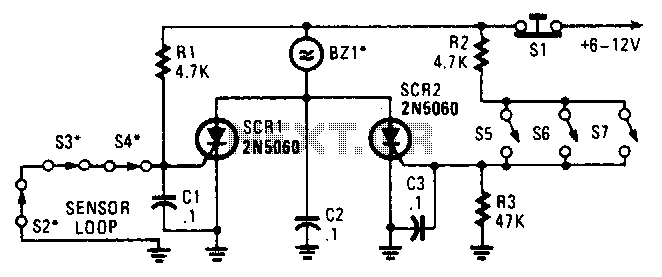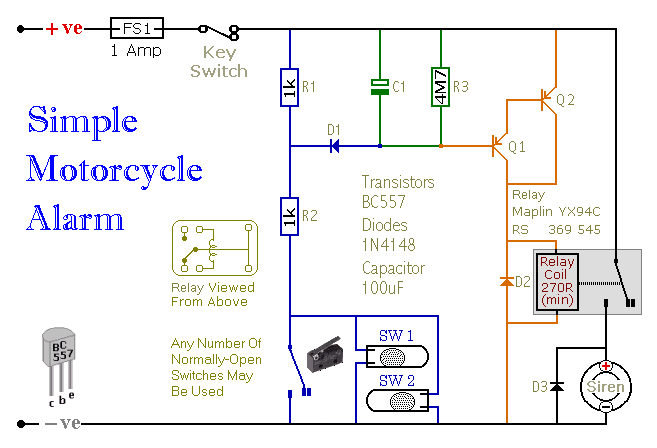
Water Level Indicator With Alarm

This circuit indicates the water level in an overhead tank and activates an alarm when the tank is full. It utilizes the commonly available CD4066 bilateral switch CMOS IC to display the water level through LEDs. When the tank is empty, the wires are open-circuited, and the 180K resistors pull the switch low, resulting in the LEDs being OFF. As water begins to fill the tank, the wire connected to S1 and the positive supply is shorted by the water, closing switch S1 and turning LED1 ON. As the water continues to rise, LEDs 2, 3, and 4 illuminate sequentially. The number of indication levels can be increased to eight by employing two CD4066 ICs in a similar configuration. When the tank is full, the water pulls the base of the BC148 transistor high, saturating the transistor and activating the buzzer. The SPST switch must be opened to deactivate the buzzer. It is important to turn the switch ON while pumping water; otherwise, the buzzer will not sound.
The circuit operates on the principle of water conductivity to create a reliable water level indicator and alarm system. The CD4066 IC functions as a bilateral switch, allowing current to flow in both directions when activated. The circuit is designed to monitor multiple levels of water, with each LED representing a specific water level. The use of a 180K resistor ensures that the switch remains open when the tank is empty, preventing false indications.
As the water level rises, conductive paths are established through the submerged wires connected to the switches. The first wire closure activates LED1, providing an initial indication of water presence. Subsequent LEDs light up as additional wires are shorted, giving a visual representation of the increasing water level. This arrangement allows for a clear and intuitive understanding of how full the tank is.
The buzzer activation is a critical feature of the circuit, serving as an alert when the tank reaches its maximum capacity. The BC148 transistor acts as a switch, which is turned ON by the water level. When the water fills the tank completely, it provides the necessary voltage to the transistor's base, allowing current to flow from the collector to the emitter, thus energizing the buzzer. The inclusion of an SPST switch allows manual control over the buzzer, enabling it to be silenced after the alarm has been triggered.
For enhanced functionality, the circuit can be expanded to indicate up to eight water levels by incorporating a second CD4066 IC. This scalability makes the design versatile and suitable for various applications, from domestic water tanks to larger industrial storage systems. Proper consideration should be given to the placement of the conductive wires and the overall circuit layout to ensure accurate operation and reliability.This circuit not only indicates the amount of water present in the overhead tank but also gives an alarm when the tank is full. The circuit uses the widely available CD4066, bilateral switch CMOS IC to indicate the water level through LEDs.
When the water is empty the wires in the tank are open circuited and the 180K resistors pulls the switch low hence opening the switch and LEDs are OFF. As the water starts filling up, first the wire in the tank connected to S1 and the + supply are shorted by water. This closes the switch S1 and turns the LED1 ON. As the water continues to fill the tank, the LEDs2, 3 and 4 light up gradually. The no. of levels of indication can be increased to 8 if 2 CD4066 ICs are used in a similar fashion. When the water is full, the base of the transistor BC148 is pulled high by the water and this saturates the transistor, turning the buzzer ON.
The SPST switch has to be opened to turn the buzzer OFF. Remember to turn the switch ON while pumping water otherwise the buzzer will not sound! 🔗 External reference
The circuit operates on the principle of water conductivity to create a reliable water level indicator and alarm system. The CD4066 IC functions as a bilateral switch, allowing current to flow in both directions when activated. The circuit is designed to monitor multiple levels of water, with each LED representing a specific water level. The use of a 180K resistor ensures that the switch remains open when the tank is empty, preventing false indications.
As the water level rises, conductive paths are established through the submerged wires connected to the switches. The first wire closure activates LED1, providing an initial indication of water presence. Subsequent LEDs light up as additional wires are shorted, giving a visual representation of the increasing water level. This arrangement allows for a clear and intuitive understanding of how full the tank is.
The buzzer activation is a critical feature of the circuit, serving as an alert when the tank reaches its maximum capacity. The BC148 transistor acts as a switch, which is turned ON by the water level. When the water fills the tank completely, it provides the necessary voltage to the transistor's base, allowing current to flow from the collector to the emitter, thus energizing the buzzer. The inclusion of an SPST switch allows manual control over the buzzer, enabling it to be silenced after the alarm has been triggered.
For enhanced functionality, the circuit can be expanded to indicate up to eight water levels by incorporating a second CD4066 IC. This scalability makes the design versatile and suitable for various applications, from domestic water tanks to larger industrial storage systems. Proper consideration should be given to the placement of the conductive wires and the overall circuit layout to ensure accurate operation and reliability.This circuit not only indicates the amount of water present in the overhead tank but also gives an alarm when the tank is full. The circuit uses the widely available CD4066, bilateral switch CMOS IC to indicate the water level through LEDs.
When the water is empty the wires in the tank are open circuited and the 180K resistors pulls the switch low hence opening the switch and LEDs are OFF. As the water starts filling up, first the wire in the tank connected to S1 and the + supply are shorted by water. This closes the switch S1 and turns the LED1 ON. As the water continues to fill the tank, the LEDs2, 3 and 4 light up gradually. The no. of levels of indication can be increased to 8 if 2 CD4066 ICs are used in a similar fashion. When the water is full, the base of the transistor BC148 is pulled high by the water and this saturates the transistor, turning the buzzer ON.
The SPST switch has to be opened to turn the buzzer OFF. Remember to turn the switch ON while pumping water otherwise the buzzer will not sound! 🔗 External reference





